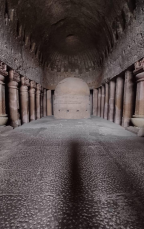Introduction:
Kanheri Caves, a collection of rock-cut structures, were created by Buddhist monks between the 2nd and 10th centuries. More than 100 caves were discovered, which were carved in live basalt rock, mainly known as Krishnagiri. Such old structures bring back the slowness and memories of the past.
Brief:
The play of sound is what animates a space, along with its relationship to other areas within a structure.
Accordingly, such caves, being hollow, produce reverberations and specific vibrations that can be felt
consciously by our minds. Not only does it give peace of mind but also the calmness one needs
subconsciously. The sound of caves has various effects on us, both perceptually and emotionally.
Meditation:
These caves were previously meditation spaces, and because of that, the silence that was created by monks before can still be heard today. Once someone enters, all the distractions and negative emotional triggers of the outside world vanish in an instant. Even if tourists make noise, the separate vibrations can be felt as if another void is present. The overall stillness of caves induces a state of calm and relaxation. The rhythmic nature of cave sounds, along with the absence of external distractions, promote a meditative environment, allowing us to disconnect from the outside world and find inner peace. Heightened Awareness: The relatively quiet atmosphere of caves enhances our sensitivity to sound. When surrounded by the natural soundscape of a cave, we become more attuned to subtle nuances and details in the environment. This heightened awareness deepens our connection to nature and our surroundings.
Water:
Caves are often associated with the sound of dripping water as groundwater seeps through cracks and
crevices. The slow and steady drops create a rhythmic and meditative sound, echoing through the caverns and adding to the cave’s ambiance. It also contains a water management system. The water flowing downhill turns into a cascade when it rains. White noise creates a sense of tranquility. The sound of water was a complex but also soothing symphony that evoked feelings of relaxation and rejuvenation. It was the sound that instantly removed stress from the mind.
Flowing and Rushing: When water moved swiftly, such as in a waterfall, it created a continuous and
powerful sound. The rushing water was a combination of a soothing whooshing and a gentle roar as it
deluged over rocks from high above.
Trickling and Babbling: In a smaller stream, the sound of water was very gentle and melodious. It trickled over pebbles, creating a calming, rhythmic babbling sound. The water’s movement at that time resembled a soft, musical gurgle as it navigated its path.
Splashing and Spraying: In some areas, the splashing water produced an invigorating sound. It ranged from rhythmic splashing to more forceful spraying, which generated a sense of liveliness and energy.
Dripping and Droplets: The sound of individual water droplets falling onto the surface of the water created a delicate and soothing ambiance. Each drop produced a distinct, resonating sound as it merged with the surrounding environment.
Echoes:
These caves are known for their exceptional echo characteristics due to the reflective surfaces of rock walls and ceilings. When sound waves bounce off these surfaces, they create prolonged reverberation and multiple repetitions of the original sound, resulting in a mesmerizing echo effect. The unique acoustic properties of caves give rise to a sense of awe and wonder. The prolonged echoes and the way sounds bounce off the walls amplify the auditory experience, making even the simplest sounds feel grand and majestic. This induces fascination and sparks our curiosity about the natural world.
Other:
Silence and Stillness: It also has a profound sense of stillness and silence. The absence of external noise, plus the natural sound-dampening properties of the cave environment, develops a serene and peaceful atmosphere that allows you to appreciate the subtle sounds of your movements or breath.
Whispers and Murmurs: Due to the unique acoustic properties of caves, even the softest sounds carry and travel long distances. The faintest whispers or murmurs were intensified, giving them an otherworldly quality within the cave’s vast, cavernous spaces.
Geological Sounds: They make geological sounds like creaking or rumbling. These sounds occur due to the movement of air currents within the cave system. While less common, they contribute to the overall sonic experience of the cave environment.
Reflection and Contemplation: The peaceful and introspective atmosphere of caves encourages self-reflection and contemplation. The solitude and calmness found within caves provide an opportunity to engage in deep thought and self-exploration.
Inspiration and Creativity: It inspires artistic expression and creativity. The unique auricular experience
stimulates our creativity and opens up new avenues for thought, resulting in original artistic works, musical creations, or even poetry statements.
Conclusion:
In the end, the sound of a cave is a fascinating experience that captivates the senses and offers a glimpse into the hidden world beneath the earth's surface. It's important to consider that the specific sounds within a cave also vary depending on its size, shape, geological composition, and the presence of water or other natural elements. Even the impact of cave sounds varies from person to person, as individual preferences and sensitivities make them sound different. Some may find solace and inspiration in the cave’s soundscape, while others may have different reactions.
About author:
Heena Velhal is a student, professional dancer, and foodie. Curiosity and being passionate are hallmarks of her personality. She possesses a thirst for knowledge and eagerly seeks opportunities to expand her
understanding of the world. Her inquisitive nature allows her to approach challenges with an open mind.



